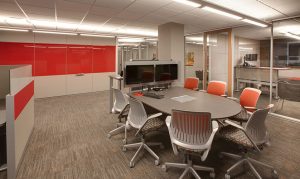Heading into the office looks different than it did three months ago. For many workers, it feels different, too. As employers put their COVID-19 preparedness and response plans into action, they’re balancing caution and optimism. Welcoming employees back into buildings requires a new sort of flexibility—a need to accommodate team members with a wide range of comfort levels on proximity and other risks of a still-evolving pandemic.
 Their buildings must do the same, architect Greg Schoer said. The way people experience their environments is shifting rapidly as they assess common areas, shared equipment, and personal bubbles on a near-constant basis during their day.
Their buildings must do the same, architect Greg Schoer said. The way people experience their environments is shifting rapidly as they assess common areas, shared equipment, and personal bubbles on a near-constant basis during their day.
“We’ve been inundated with news stories on people’s health, safety, and wellness,” Schoer said. His company, TSP, Inc., this week started its return to offices for the architects, engineers, interior-design specialists, and support staff who’ve worked from home since mid-March. “This same attention to those topics is among our main concerns. We work with businesses to plan and design environments that encourage wellbeing. The building occupant’s health and the building’s health are absolutely correlated.”
Click here for a list of practical resources for your business.
Thoughtful design adaptations and building-system tweaks can help companies find a new normal that also provides a return on investment when they’re ready to move to the next phase in their recovery plans. Now in its 90th year, TSP is developing customized solutions for some nearly universal shared-space challenges. Tackling these issues together with clients demands listening, creative use of space, and staying up-to-the-moment on the latest guidance. Incremental, reactive changes now are likely to affect near- and mid-range trends intended to “future-proof” buildings against what we don’t yet know—whether the science centers on our understanding of COVID-19 or the next public-health outbreak headed our way.
The human component
These adjustments also are worth considering to help save on any organization’s largest expense: personnel. Employees who feel unsafe at work are risking their emotional and mental health to provide financial security for their families. That can erode faith in and loyalty to their organization, cause business losses due to distracted productivity, and drive a costly need to fill positions when employees leave for a better working environment elsewhere.
Space programming, building systems, and products are tools to support—not solve—issues that largely are driven by behavior and entrenched habits.
 “If you make an architectural intervention in an office layout, you have to think about the accompanying staffing procedures that go along with it,” said TSP senior architect Brian Johnson. “If you get really intentional about differentiating spaces for breakout areas within an office or individual workstations that are more protected, what happens when that team goes back to a standard open-office environment and greater risk exposure? If you create a team-room kind of concept and block scheduling or rotations, that team has to stick together for a while.”
“If you make an architectural intervention in an office layout, you have to think about the accompanying staffing procedures that go along with it,” said TSP senior architect Brian Johnson. “If you get really intentional about differentiating spaces for breakout areas within an office or individual workstations that are more protected, what happens when that team goes back to a standard open-office environment and greater risk exposure? If you create a team-room kind of concept and block scheduling or rotations, that team has to stick together for a while.”
Schoer faced some of those issues head-on when Lutheran Social Services of South Dakota asked TSP to adjust occupancy calculations across several buildings to align with a since-repealed Sioux Falls capacity ordinance.
 “We expect some companies will look back on this experience and decide they don’t need the same footprint they have now,” said Von Petersen, a senior architect who leads TSP’s office in Rochester, MN. “Maybe a school needs bigger or more classrooms to give each person more room. But people still can spread out in a smaller space on a day-to-day basis if the new model breaks up when people are in the building. Maybe you treat coming into the office as something special for the truly collaborative parts of what you do together—and design it with those safe gathering areas. That model keeps more people working from remote locations if that’s where they can be productive. Not every position can do that, but not everyone works best in the typical open-office setting, either. It’s good for businesses if they can take what they’ve learned from this and apply it to save on building costs. Everyone is looking for ways to be smarter about how they operate in the future.”
“We expect some companies will look back on this experience and decide they don’t need the same footprint they have now,” said Von Petersen, a senior architect who leads TSP’s office in Rochester, MN. “Maybe a school needs bigger or more classrooms to give each person more room. But people still can spread out in a smaller space on a day-to-day basis if the new model breaks up when people are in the building. Maybe you treat coming into the office as something special for the truly collaborative parts of what you do together—and design it with those safe gathering areas. That model keeps more people working from remote locations if that’s where they can be productive. Not every position can do that, but not everyone works best in the typical open-office setting, either. It’s good for businesses if they can take what they’ve learned from this and apply it to save on building costs. Everyone is looking for ways to be smarter about how they operate in the future.”
The best of both worlds
Like other regional firms, TSP is navigating restrictions across multiple state lines. Its office in Sioux Falls, SD, houses the greatest number of workers and will follow group scheduling for Week A and Week B teams. A split approach allows businesses to control the number and proximity of workers in the building at standard times, but it’s only one strategy for managers to consider.
States and communities across TSP’s footprint now are finding their way forward from stopgap orders and other restrictions intended to help flatten the COVID-19 curve. While most closures and capacity restrictions were temporary, those experiences raised lingering questions for business owners. Suddenly, every manager had to think like a designer. Entry vestibules became overnight holding areas for packages and smaller deliveries of supplies. Executives obsessed over the logistics of site and facility access, traffic patterns between private/public areas or multiple levels, impromptu employee interactions in hallways and break rooms. Companies took a hard look at how to group certain functions together—or separate them entirely, as the case called for it.
“A lot of people worked at home for the first time in their careers, and I think many people liked some of the convenience of it,” Petersen said. “They’ve enjoyed not commuting and having the privacy of their own space, so that might change how everyone gets back together again. Maybe cubicles in an open floor plan still is the most efficient, but an office might have ‘phone-booth’ kind of rooms to fit a single person on a video call.”
Intentionally differentiating spaces within the office helps control the number of workers in different functional areas for collaboration, cubicle workstations, and private offices. Demountable wall panels from DIRTT and other leading manufacturers create flexible, semi-permanent solutions for businesses. Available in glass and opaque panels, provide an answer to create rooms-within-rooms. The wall systems even can be configured with embedded wiring to power monitors, tablets, laptops, and other mobile-technology devices. TSP designers have put them to use in recent years for Sweetman Construction/Concrete Materials’ corporate headquarters, the Wealth Management offices at The First National Bank in Sioux Falls, and North Education Center in New Hope, MN. Those clients appreciated the flexibility to move partitions as their workforces, student bodies, and administrators changed in number and team functions. Now, companies are seeing opportunities to section off semi-private workspaces without the need for expensive, less-reversible full-scale interior remodels.
Filters and indoor air quality
It’s equally important to consider changes in building-system design. As an integrated, multidisciplinary firm, TSP assembles teams whose mechanical, electrical, and structural engineers are directly involved with architects and interior designers from a project’s earliest stages. That approach is well-suited for what’s next: the complex mix of interconnected systems needed in a low-touch economy.
Industries that were moving toward those practices before the coronavirus will be early adapters of more sophisticated automation—building on the successes of sensors for room lighting and temperature controls, door-access systems and near-field communication (NFC) for touchless payments.
 But thorough planning also requires some harder acknowledgments. Certain risk factors remain beyond control in non-healthcare environments. An office building can’t perform at the same level to eliminate viruses and bacteria. And it’s impractical to overdesign them to reach that goal, according to TSP senior mechanical engineer Roger Nikolas. During his 30-year career, he has designed complex systems for hospitals, clean rooms, and laboratory settings. The components in more typical HVAC systems are intended to trap larger particles—dust as well as some mold and pollen spores. This assures systems remain free of contaminants that drive down efficiency, requiring more energy to achieve the same cooling effect and shortening the equipment’s lifespan.
But thorough planning also requires some harder acknowledgments. Certain risk factors remain beyond control in non-healthcare environments. An office building can’t perform at the same level to eliminate viruses and bacteria. And it’s impractical to overdesign them to reach that goal, according to TSP senior mechanical engineer Roger Nikolas. During his 30-year career, he has designed complex systems for hospitals, clean rooms, and laboratory settings. The components in more typical HVAC systems are intended to trap larger particles—dust as well as some mold and pollen spores. This assures systems remain free of contaminants that drive down efficiency, requiring more energy to achieve the same cooling effect and shortening the equipment’s lifespan.
Click here for insight on how to even the battlefield in this summer’s thermostat wars
“When the COVID-19 outbreak began, there was some debate about how to best reduce airborne spread of the virus. Was it better for offices and schools to keep the fans off as much as possible or to run them continuously?” Nikolas said. Recently, the American Society of Heating, Refrigerating, and Air-conditioning Engineers (ASHRAE) put out formal recommendations for those facilities to continue regular airflow and fan speeds.
“Another recommendation said that offices, schools, and similar facilities should discontinue using demand-controlled ventilation, or DCV, to keep outdoor airflow rates as high as possible. That replaces more building air with fresh air,” Nikolas said, though he stresses the importance of understanding a system’s limitations. “We have to consider the equipment’s cooling and heating capacity whenever we make any modifications to these kinds of control strategies,” he said. “If the outdoor airflow rate is above the equipment’s design capacity, it can cause temperature- or humidity-control issues during extreme weather.”
A new awareness
The COVID-19 pandemic has disrupted modern life and the economy in ways we haven’t yet fully realized. It’s also interrupted daily routines and made people re-examine their surroundings.
“This event has reactivated an awareness of the buildings, plazas, and playgrounds we’ve taken for granted,” architect Schoer said. “It’s allowed the majority of us to pause and evaluate the spaces around us, no matter what type of business or industry we’re a part of.”

